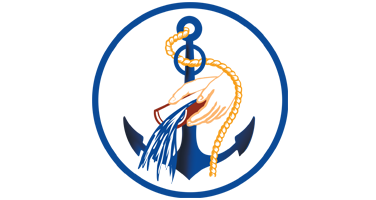
In a few clicks, here are some answers to commonly asked questions.
What does the symbol mean that serves as the logo for all your publications?
The emblem of the anchor and the source

In the Rila Mountains of Bulgaria, Master Peter Deunov specially arranged a spring that flowed from a large granite block, later carved into the shape of a prow. The water first flowed over a bed of white stones, then between two joined hands sculpted from quartz. On one side of the rock, a marine anchor is engraved and painted blue. This anchor and this flowing water are symbols of our Fraternity, two figures, two representations of the same spiritual ideal: the flowing water represents love, infinite divine life, and the anchor, stable and reliable, protects this sacred life from the slightest deviations.
The anchor
The anchor immediately makes us think of the marine world and boats. Its function is to connect the ship to the seabed when it is at anchor or in port: it gives it the necessary stability and secures those on board. Of course, it is in the storm that the anchor proves powerful, indispensable to avoid being swept away by the current or drifting at the mercy of the winds. A human being, like a ship, can also be swept away by the fluctuations of life, drift off course or get lost if they are not firmly anchored to a principle, namely an unchanging divine principle – the rope symbolizing the link between matter and the divine spirit.
On a spiritual level of consciousness, the anchor is a symbol of hope. In early Christianity, Saint Paul said in the Epistle to the Hebrews: ‘This hope we have as an anchor of the soul, both sure and steadfast.” (6, 19)
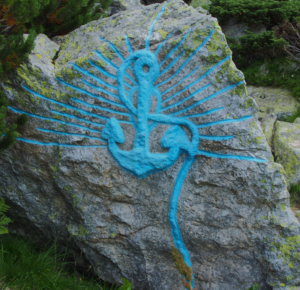
On what should we base our hope? On the certainty that the future can always be better, even if the present is not so great. In the Creator’s plans, it is always the powers of life and good that will ultimately triumph. But while we wait for better days, we must hold firm, have faith, nurture life within us, and it is through love that we nurture life. Otherwise, hope will be a flight from reality, and one day it will abandon us. Hope is the strong union of our soul with the Creator; it attracts peace, it is the blue colour of the sky, of harmony and truth. This deep peace that invades us becomes silence; everything appears clearer to us, Heaven is reflected in our soul like on the still surface of a lake, we contemplate truth; this truth is that God created man in His image, and this image contains in potential all riches, all victories, and all joys.
Water
Water is the symbol of life, and the water flowing from a source is the image of the perpetual renewal of life. This uninterrupted gushing of water allows the source to remain always clear, always alive, always pure; even if some dirt is thrown into it, the current carries it away.
Water is among the four elements the one that most intimately mixes with our organism. Therefore, when we touch or drink it, the first condition is to approach it with respect, consideration, and love. The beautiful and pure entities living in it will then put us in communication with the elements it contains, with the forces of the universe.
In each of us, there is also a source, which teaches us that there is only one true method to create and maintain life: to give (like clasped hands) the best of what we have in our heart and soul. Letting the water flow also means never ceasing to love. Whatever happens to us, we must never close our heart, for that would allow the desert to settle within us. On the contrary, remaining connected to the Source of life, to light and love, means being infinitely supported, inspired, and nourished. In spiritual life, the image of the source and the flowing water is a model and a teaching. Master Omraam Mikhaël Aïvanhov says that the riverbed, the path through which the water flows and allows us to return to the Source, is wisdom. Life, that is to say, the water that waters the stones, the plants, that quenches the thirst of animals and humans, is love. And the Source from which life springs is truth. The image of the anchor invites us to develop stability, a firm and solid attachment of our spiritual life to the earth. Being stable means being faithful to our inner commitments and, whatever happens, walking on the path of light.
The Circle
The circle is the image of the sun, a symbol of unity, harmony, a new Golden Age for humanity, a universal brotherhood.
On this rock of the Rila Spring, there is the following Bulgarian inscription given by Master Beinsa Douno (Peter Deunov):
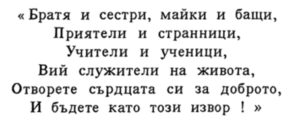
Which means:
Brothers and sisters, fathers and mothers,
Friends and strangers,
Teachers and students,
You, servants of life,
Open your heart to goodness,
Be like this spring!
What meaning does your Teaching give to the word resurrection?
What the initiate school of Master Omraam Mikhaël Aïvanhov offers is that it aims to transform our own matter, our cells, the atoms and electrons that constitute us, so that they vibrate at such an intensity that our entire body becomes capable of resonating with the life and light of the universe, to open doors to the Powers of good that seek to penetrate the material world, to touch human consciences. This is the specificity of our teaching, this spiritual galvanoplasty that we perform day after day on our own cells, on the materials of our physical body to make it so pure and transparent that it can express, manifest, welcome, the celestial light.
For this, the Master gives us multiple original methods to develop ourselves on all planes. He synthesizes the disciple’s work through a table, the synoptic table. There is no progress without overcoming, regardless of the plane. So, we have manual, material activities to help elevate the particles that make up our bodies, but we also have creative, artistic activities, moments of conviviality, music and songs to nourish our feelings, we have places of study for the teaching to nourish our intellect, and we have activities of prayer and contemplation to nourish our soul, meditation and identification to nourish our spirit. This is the entire program of the initiate school, and it is what leads to the new birth, resurrection.
If each of us became aware of this gigantic mission to transform our own matter so that it can vibrate in harmony with the currents of divine light to the point where we become like suns ourselves, at that moment our collective meditations would release an unprecedented luminous force that the Master has often spoken about when evoking the ‘spiritual laser.’
The spiritual laser purifies our own matter to the point where it is capable of radiating by itself; the light must not be external to us, we must be the light, and if we achieve this collectively, in a relationship of harmony and mutual love with all creation, a remarkable spiritual force is released, capable of transforming the world. This is how the symbol of Easter and resurrection is understood by the children of the Universal White Brotherhood.
Why follow a spiritual teaching?
Let’s take the example of someone who wants to play a musical instrument, or another who wishes to climb a high mountain. Both would seek the assistance of a teacher, the help of a guide to navigate unfamiliar terrain. A teacher or guide will always be there to provide methods, exercises to do, correct your mistakes, warn you of dangers, and offer encouragement. This is because they possess knowledge and experience that beginners lack; they have learned to strengthen themselves and overcome all obstacles.
The same applies to spiritual teaching. Those who decide to follow it should seek nothing other than methods for self-improvement. It is in an initiatory school that they will have good conditions to introduce order and harmony within themselves, allowing their divine nature to flourish and undertake a massive task.
Many, however, imagine that spiritual teaching will reveal secrets to them, making their difficulties disappear as if by magic, with the hope of becoming rich, influential, and powerful. No, the purpose of spiritual teaching is to connect us with Heaven, to experience emotions and states of consciousness of a higher order that will allow us to discover other regions within ourselves. It is an inner work where the heart, soul, and spirit play the greatest part.
Is white compatible with universal?
The word “white” has a similar symbolic meaning from one civilization to another.
The colour white is generally associated with the idea of daylight, and as a result of the idea of good morality. Black, depending on whether it is associated with night or darkness, is more ambivalent. But dawn, daylight or sunlight always have a positive touch.
From a cultural point of view, white is the colour of peace : people at war wave a white flag to call for a cessation of hostilities ; while red is the symbol of war. The dove of peace is white. White is also associated with the immaculate purity of snow. Or with the sweet tenderness of a breastmilk, symbol of love and life.
In physics, white light represents the synthesis of all colours. Scientists show that when white light passes through a prism, it is divided into countless colours. In a symbolic way, therefore, the white colour embraces and brings together the opposing parts or the different colours. Leonardo da Vinci, inspired by an intuition from his practice as a painter, considered that “white is not a colour by itself, it is the receptacle of all colours”.
In this sense, white reflects a value of universality : it somehow condenses diversity and wholeness, adding to it the symbolism of peace or harmony.
In accordance with this theme, the term “universal white brotherhood” seeks to convey the idea that all human beings, with no exception and with all their diversity, are invited to create around them a brotherly, harmonious life in respect of each origin, culture, belief or conviction.
Finally, from a spiritual point of view, the color white symbolizes the luminous radiance of the virtues of the soul. Purity, selflessness, the holiness of a man or woman emanate and radiate around them like a white and rainbow coloured halo, regardless of their physical appearance or the colour of their skin.
What is the content of this teaching?
The philosophy of Master Omraam Mikhaël Aïvanhov is about living a fulfilling and meaningful life. It addresses essential issues that concern everyone, such as the meaning of existence, life and death, happiness or also love, and it helps us to better understand them. In doing so, it provides the keys to getting to know ourselves, to develop ourselves and to overcome the challenges we face in our life.
Who is your God?
There is only one God, there is not our God or your God.
God is one.
The human languages give Him different names, but He doesn’t belong to anyone, He opens Himself to all and to each one.
He is the life, the light and the love given to all creatures.
How to define prayer?
Prayer is the possibility given to man to access another dimension, it is a request made to the divine, to our Higher Self. For the divine world to grant our prayers, it involves triggering a process that will amplify until their realization. To do this, we must start by doing some work, planting a seed, and this seed will one day become a tree.
What is your view on health?
Our health depends strongly on our lifestyle. Not only is it important to eat healthy, to breathe fresh air, but it is also important to have good thoughts and feelings in order to stay healthy. In addition to food, our thoughts and emotions have an impact on our health. For this purpose, the Master has given several methods to live a healthy, pure and harmonious life. The best medicine is a daily practice of a certain lifestyle, that is, the way we think, feel, believe, love and nourish ourselves.
You talk about brotherly love towards all humans, but can one really love everyone?
To love is not just to be in love. As we all know, there are several forms of love: passionate, altruistic, maternal, brotherly, mystical, and so on… Some forms of love have their origin in physical attachments, others in affinities, sympathy, while others are inspired by a more impersonal understanding that each human being is governed by the same universal flow of life that runs through all creatures.
It is this feeling of unity that gives us the opportunity to overcome our apparent differences and to love the whole world. This impersonal love strengthens us, for it echoes in us with the infinite brotherhood of small and great worlds, visible and invisible, which some call the kingdom of God.
Can one spiritualize love and sexuality?
Read pages Sexuality (1) to (7) in the section ‘About Bioethics‘.
The unity in the Teaching
The spiritual teaching of Master Omraam Mikhaël Aïvanhov is known to be heir to the Christian esoteric teaching of his Master Peter Deunov. He is imbued with the same veneration of the Bible, the Gospels and the sublime figure of Jesus Christ.
Master Omraam is faithful to this spiritual heritage. But his broader vision of the world takes into account many other wisdoms or cultures spread throughout humanity. During his youth he studied various subjects at university and read a lot – although he likes to present himself as an ignorant person. He truly belongs to his century. He is interested in everything, in societies, science, technology and in the new discoveries that foreshadow the Age of Aquarius, that period characterized by tolerance and brotherhood which he wishes for humanity throughout his whole life. Invited to many countries, he travels and meets countless people from all walks of life and from different religions.
Although in the 20th century the international situation forbids or stifles exchanges – two wars, the “cold war”, the “iron curtain”, anti-colonial struggles -, it is a time when new means of communication are multiplying and he is interested by them: rapid means of transportation, radio, movies, television, publishing, newspapers, the early days of computers… Cultures meet and interpenetrate more and more. Christianity discovers that it is not the prerogative of the whole truth, for the Spirit is larger than a single religion.
Intuitively an Initiate “feels” his era: his soul is connected to the collective human soul by all the subtle threads of understanding, care, compassion and love. The Master has made himself a multiple soul. To every being who comes to him, he asks fraternally: “How can I be useful to you?” and maybe this is the true religion.
In his wisdom we find essential features of ancient philosophies: the Tao, the Vedas, the Upanishads, the Bhagavad Gita, Confucianism, the Presocratics, Orphism, Pythagorism, Plato, the Neoplatonists… Not quotations sewn together without any continuity, but a coherent vision of the world. He often quotes and comments on the Emerald Table of Hermes Trismegistus or on key phrases of mazdeism. He studies and interprets astrology and alchemy, and deciphers the initiations of the Pyramids. He explains the spirit of Vessak, the Buddhist celebration of the full moon of May. He shows esteem for Muslim piety, for Sikkhism… He spent a year in India, visiting the whole peninsula, and quite naturally referring to the existence of various yogas so as to establish himself two new practices which he calls “yoga of nutrition” and “yoga of sunrise”… Surya, the sun, origin of all life on our planet Earth, source of invigorating light that nourishes all our bodies, physical and subtle… the sun, open door to the Divinity… He always refers, almost daily, to the Bible or the Gospels. He exposes extensively the living arrangement of the sephiroths of the Jewish Kabbalah and advises his disciples to explore it as a method of understanding the invisible world and as a path of prayer. In his understanding of Living Nature, he mentions the spirits of the four elements of nature, much as the Celtic world saw them or as animism, shamanism, etc. felt them….
Listening to him, one realizes how much all these philosophies or these various forms of devotion, love and respect for the luminous beings of the invisible world fit harmoniously into his vision of the world. It would be a mistake to listen to or read only two or three of the five thousand or so lectures he has given, and to judge that his teaching is made up of bits and pieces gleaned here and there by chance. The serious student who seeks to live this wisdom from within, feels that beneath this diversity of references there is a burning flame that unites them.
An inner unity, for this teaching has a coherence that is organic, so to speak. *
An external unity with other traditions: listening to the words of Master Omraam, one feels a kinship with all the authentic spiritual traditions of humanity. For they all come from a single source of Eternal Wisdom: even without historical proof, the disciple has an intuitive certainty of this.
This inner and outer unity that we so deeply feel, where does it come from? From the shared idea of light. Towards what does it tend to? Towards the light, the incarnation of light in the earthly world.
In all religions or spiritual traditions, the Master has identified, selected and put within our reach an essential theme: Divine Light. His teaching is centered on this unique source from which he draws himself.
Love of the Light, fusion with the Light, consecration of the whole being to the Light that springs from the heart of God.
(January 2020)
* On this subject, see the “Synoptic Table”, elaborated by Master Omraam himself, a synthesis of all the methods he recommends and their objectives, Coll. Synopsis n° 2, part III, 1
What important dimension does the teaching of Master Omraam Mikhaël Aïvanhov give to the Masculine-Feminine relationship?
The science of the two principles, masculine and feminine, is the science of cosmic balance. The masculine principle is the emissive principle that projects, sows, and gives the germ of life. The feminine principle is the principle that gathers, organizes, and nourishes, to produce a complete, perfect work. One sends out waves, forces, but it will be in vain if there is no other principle that responds, receives, and works on what it has received. There is no need to overestimate or underestimate the importance of one or the other; both are equally important, equally indispensable, but in two different domains. The positive pole exerts an attraction on the negative pole, and the negative pole an attraction on the positive pole: it is from the existence of these two poles that the universe was born. This mechanism of reciprocal action and reaction triggers and maintains the movement of life.
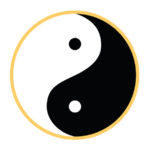 Physically, we are born male or female, but psychologically we possess both principles, masculine and feminine. That is why we cannot equate man with the masculine principle and woman with the feminine principle; neither is an abstract principle, but a combination of both. In the Chinese symbolism of yin-yang, for example, the yin part, black, feminine, contains a white point, and the yang part, white, masculine, contains a black point, to express that the masculine always contains a part of the feminine, and the feminine always a part of the masculine.
Physically, we are born male or female, but psychologically we possess both principles, masculine and feminine. That is why we cannot equate man with the masculine principle and woman with the feminine principle; neither is an abstract principle, but a combination of both. In the Chinese symbolism of yin-yang, for example, the yin part, black, feminine, contains a white point, and the yang part, white, masculine, contains a black point, to express that the masculine always contains a part of the feminine, and the feminine always a part of the masculine.
In art and painting, we often find works that represent a king or an Initiate sitting on a throne, holding a staff or scepter in his right hand and a sphere in his left. Symbolically, the scepter and the sphere represent the two masculine and feminine principles, the first always expressed by a straight line like a caduceus, a sword, a pillar, the second by a globe, a rounded object that gathers like a cup. We can think of the cup of the Grail in esoteric tradition.
In many tales or initiatory stories, it is the same; the objects mentioned are realities of spiritual life. Thus, the shield or armor worn by the knight is the symbol of the aura that surrounds and protects him, the feminine principle. And his sword, the masculine principle, is the light projected by his thought. These two symbols, which date back to the highest antiquity, represent the existence of these two necessary aspects, active and passive, for any creative work.
We can evoke other symbols representative of these two principles, such as the following examples: bread and wine in the Catholic religion, communion being the most significant moment of the mass, since bread and wine represent these two eternal principles. Fullness and emptiness do not exist in themselves but are complementary. The cross itself is a symbol, a cosmic reality, whose deepest meaning is that of matter (horizontal line) into which the spirit (vertical line) descends to vivify it. The hexagram or Seal of Solomon is composed of two intertwined triangles, the feminine and the masculine. Fire and water—this one contained in a vessel and placed above the fire will be exalted and produce, thanks to steam, a considerable release of energy. The Sun and the Moon with which alchemists work, that is, the will (the Sun) and the imagination (the Moon). The spirit and matter—matter would be opaque, inert, it could not express itself if there were not the active, dynamic principle, a flame, the spirit that manifests through it. Matter is also our physical body, it retains our soul and spirit, like a flask that retains the volatile perfume and prevents it from evaporating.
“The two masculine and feminine principles, which are the two principles of spirit and matter, have their origin in the celestial regions. But these two principles act in all planes, because it is in all planes that their polarity manifests. You yourself, when you work, are the spirit acting on matter. This is already true when you want to make an object or even simply prepare a meal. But it is even more true for spiritual activity. As soon as you become aware of the need to improve certain things in yourself and decide to do this work, you polarize: there is the masculine principle—you yourself, your spirit—and the feminine principle—your psychic matter—on which you want to work… You must therefore learn to distinguish the self from the non-self, and move away from what you ordinarily call your self, but which in reality is not you, to approach what is truly you: your Divine Self. That is when the true work of the spirit on matter begins.”
Omraam Mikhaël Aïvanhov, Daily Thought, October 2, 2018
“All Initiations, those of the past as well as those of today, teach only one thing: how to achieve the union of spirit and matter. Yes, one thing only, the union, the fusion of spirit and matter, of the human being and his Creator, but the explanations, presentations, aspects are infinite. For there are thousands of knowledge to be acquired to achieve this fusion. All sciences are there to serve a single purpose: to unite with Divinity, to merge with the First Cause.“
Omraam Mikhaël Aïvanhov, Daily Thought, June 27, 2023
Is the Wesak festival always celebrated in May?
Wesak is a very important Buddhist festival, as it commemorates both the birth of Buddha, his enlightenment, and his departure from this earth. Buddhist communities around the world celebrate it on a traditional date, known in the West as the ‘May full moon.’ Some years, there are two full moons in May. At that time, an official date to celebrate the festival is chosen and fixed by the various Buddhist communities, and this decision rightfully belongs to them.
However, one can pay attention to the perception developed by Omraam Mikhaël Aïvanhov when he first spoke about this festival in a conference he gave in Paris on the full moon Saturday, May 14, 1938: ‘The mystery of the two fish and the five loaves.’ His exceptional skills in astrology led him that evening to relate seemingly unrelated elements: the influences of the Sun in Taurus – Moon in Scorpio; the spirit of the Buddhist Wesak; the Gospel episode of Jesus multiplying bread; and more surprisingly, the annual migration of eels to the Sargasso Sea to reproduce.
His mystical intuition connected these four domains in a lively way through the notion of multiplication, abundance, fertility, fecundity, dissemination, gift, generosity… For the Buddhist Wesak represents above all a great sacred ceremony during which the great Initiates gather in a secret place in the Himalayas, either physically or through astral projection, and from there project and disseminate with love thousands of luminous thoughts towards humanity, for its spiritual evolution and salvation.
And according to Master Omraam Mikhaël Aïvanhov, it is this configuration of the Sun in Taurus – Moon in Scorpio that influences the spirit of fertility of Wesak, rather than the following full moon, Sun in Gemini – Moon in Sagittarius, which will bring different influences. That’s why, some years, the true astrological full moon of May is the first of two full moons in May. Or even – a surprising case for Cartesian minds accustomed to the Gregorian calendar – other years the so-called ‘May’ full moon occurs in April!
In reality, the date of this Buddhist festival does not depend on the Gregorian calendar, but on the Hindu calendar: it corresponds to the first full moon of the lunar month named in Sanskrit ‘Vaiśākha’; hence the name Wesak.

What does the word " esoterism " mean to you? A philosophy that is difficult to understand? Only for a small number of people?
What does the word ” esoterism ” mean to you? A philosophy that is difficult to understand? Only for a small number of people?
The word “esoteric” comes from the Greek “esôteros” meaning: which is inside.
Esoterism means not only a vision of the world, but also a behavior in life, easy to understand and open to all those who wish sincerely to get to the heart of things.
The esoteric attitude is, so to speak, an attention that is born and that grows silently within, it is the life of the soul. It’s just as mysterious and simple as love.
“Look,” said the guide to the visitors on Heritage Day, “here is a scene depicting the Last Supper, Jesus and his apostles. You will recognize some of them: Judas by holding a pouch of money, Peter by holding a sword, and John by leaning on the heart of the Christ. »
It is John’s attitude that, in our eyes, reveals the meaning of the word ” esoterism “.
What is the meaning of the word 'race' in the thought of Omraam Mikhaël Aïvanhov?
It is known that words, depending on the context, have different meanings (for example, the word “class” will not have the same meaning for a school teacher, a military person, or a sociologist). In the West, it was long the practice to use the word “race” to refer to physical, anatomical characteristics that designate a particular ethnicity. In spiritual traditions, which are generally universalist, this is not the case: for them, the word “race” has another meaning related to the progress of souls.
In India, there is a Sanskrit word, “manvantara,” which is used to describe a cycle of human manifestation on Earth during a very vast period of evolution. Because billions of humans are on Earth to evolve: through their successive existences, they learn, grow, mature, and emerge with an increasingly clear consciousness of their nature and place in the universe.
The spiritual tradition considers humans to be souls, souls in the making, incarnated on Earth to evolve; and physical appearance, ethnic characteristics, skin color, eye color, hair color, etc., are secondary.
Humanity is called by the Cosmic Intelligence to evolve collectively, like the other realms of nature, towards the most perfect possible blossoming of its functions and talents. But of course, this collective evolution extends over very long periods, over many millennia. And these periods represent sorts of study cycles, waves of growth, or successive stages of emergence of consciousness; a bit like a child develops over the years, passing through several types of mentality, understanding of things, aspirations…
In the thought of Omraam Mikhaël Aïvanhov, the word “race” therefore designates a wave of evolution, a state of consciousness conquered through great struggle and which will be surpassed, a transitional stage of humanity. It is a vast dynamic thrust, not a fixed biological schema once and for all.
Esoteric tradition has called our current stage of evolution the “fifth race.” With humour, O. M. Aïvanhov characterizes it as the “reign of paperwork”: he thus highlights excessive intellectualism, which must be balanced by all the riches of the heart.
He invites us to move on to the next stage, the “sixth race,” that is, an era where we will give primacy to the expression of pure, authentic, joyful, and spontaneous life. Each person, through subtle work on themselves, will sculpt and mould themselves like a masterpiece. The face, the gaze, the words, the gestures, the subtle emanations, the aura… the entire being will dance and sing, revealing a luminous beauty.
Humans will accord supreme value to fraternal behaviour, and our societies will be founded on the laws of love and wisdom.
What does the expression 'Kingdom of God' mean to you? Is it a matter of political regime, monarchy, or royalism?
The French language commonly uses expressions like ‘peace reigns; a great silence reigns; a family where good understanding reigns’; etc. Everyone understands that this is not about a political regime, but about atmosphere, ambience, climate, state of mind.
God is ‘king’ in the sense that He diffuses and gives Himself originally in all things and all beings as a power of life.
At the level of human societies, what Jewish and Christian tradition has called the ‘Kingdom of God’ is an atmosphere of harmony, mutual understanding, ‘justice’ in the sense that each person respects and gives to others what is due to them, thus making peace possible.
At the individual level, it is a state of mind, a state of consciousness, a disposition of the heart and will that fosters tranquility, health, harmony, happiness.
What Master Omraam calls the ‘Kingdom of God’ can be realized internally under any political regime: it is a fraternal love among all humans, so rich and irresistible that it overflows towards all creatures of the planet and the universe.
According to you, which objectives are your priorities?
The philosophy of Master Omraam Mikhaël Aïvanhov focuses on two questions which are closely linked: the development of the human being and brotherhood.
If the Master deals with subjects such as the Kabbalah, astrology or alchemy, he addresses all of these disciplines with the objective of giving the human being the elements he needs to live a beautiful and meaningful life. The priority is not so much the acquisition of esoteric knowledge but the way of living: it is by improving the way we live that we will be able to understand the deep meaning of life.
He emphasizes the importance and benefits of community life for the development of the human being. Living amongst others, doing things together, allows each person to get to know himself or herself better, to be confronted with his or her weaknesses and to make efforts to improve.
Collective life must also lead us to become aware of the link that unites humans to one another. All are brothers and sisters in a large family and we learn to cultivate and nurture this relationship in order to form a brotherhood, that is to say, a community in which there is more love between human beings. This is the reason why fraternal centers have been created. These centers are schools in which we practice living a brotherly life and develop the awareness that we are all members of one universal family.
Throughout the year, several meetings are organized in the fraternal centers in order to allow those who are interested to come and live a fraternal life and to practice the methods and exercises that have been given by Omraam Mikhaël Aïvanhov. Among these methods are meditation, watching the sunrise, breathing and gymnastic exercises, paneurythmia, the yoga of nutrition or music and choral singing.
Freedom
Being free is not about satisfying all our desires, living an easy life, giving in to laziness, pleasures, passions, abandoning our responsibilities, and not fulfilling our commitments and duties towards our family and society. No, because sooner or later we will inevitably encounter new obstacles, new servitudes that will show us that we are mistaken and limiting ourselves. So, what does our freedom in life consist of? Understanding where our interest lies and choosing the direction we want to take to truly flourish.
Indeed, the less we control our thoughts, desires, and whims, the more we become dependent, slaves to ourselves. Are we truly aware that we are influenced and often directed by other human beings, by inner forces, by entities from the invisible world that decide for us? If we want to break free from these constraints, whatever they may be, the only way out is to strive to rise higher and higher, to approach the summit, to reach towards the Lord.
Freedom is conquered through self-control, through mastering our impulses, until we achieve inner freedom: it is this that will allow us to discover the essential truths we need to guide and support us in life. All the wonders of heaven and earth are around us and within us, but to see and understand them, we must be free, internally free.
How do we use our freedom? Can we understand with accuracy whether it is preferable to take one direction or make one choice rather than another? And if the best way to use our freedom was to serve the Divine Principle, to serve the light, to dedicate our lives to opening a path through which the currents of the higher world can descend to act upon the earth, transform it, purify it?
The science of the Initiates tells us that a human being is only free when he is merged with the Cosmic Spirit, because only the Cosmic Spirit, the Creator, is absolutely free. All creatures in the universe are immersed in the soul of the Lord and receive His influence; they are free with the freedom of the Lord, but not free from Him: if they move away from Him, they lose their freedom. True freedom is to bind ourselves to God as well as to all visible and invisible creatures carrying pure life, so that we too can participate in their work.
What difference do you make between a community and a fraternity?
A human community is not yet a fraternity. Let’s take the example of a city: do all the individuals living there know each other, appreciate each other, understand each other, and consciously work for one another with love? The concerns of most people remain focused on themselves; they seek to satisfy their desire for success and personal well-being: how to dress, find housing, eat, earn money, raise children… If externally they live organized in societies, internally each person works and lives separately, isolated, sometimes even aggressive and hostile towards others. Seen from this angle, collective life can only be superficial; it cannot last, it is never secure, and from one day to the next, everything can be lost, even life.
What do the Initiates say? Should we live in solitude, withdrawn from the world, to evolve? On the contrary, they say that this era is over; now is the era of fraternity, the gathering of all human beings who want to walk hand in hand to form a vast family. But if it is easy to have good relationships, to understand or group by affinities, it is another matter when it comes to all countries, all nations on earth living together. They have their own vision of the world, different religions, political and economic systems, different traditions. It will be a prodigious science to unite all peoples, and not just gather a few.
This is indeed the purpose of a spiritual community: to acquire a broad, luminous consciousness where members are united among themselves, with the ideal of working for the good of the entire world. Once again, it is first internally, spiritually, that beings will manage to form the true ideal society, universal fraternity. To embark on this magnificent endeavour, one must be able to pursue it to the end, persevere in efforts without faltering, knowing that one will be driven, stimulated, and influenced by the example of others.
Universal fraternity is a cosmic community; it includes all luminous creatures in the universe up to God Himself. Here on earth, we can unite with this immense community through prayer and meditation, project light far into space to touch human hearts with a divine idea: the sublime consciousness of universality.
What do you call the "High Ideal"?
He who nourishes a great ideal of spiritual elevation, the High Ideal, connects himself with a superior world, the only food capable of nourishing his soul and spirit.
The high ideal rallies and directs our energies, it gives them the right direction and the right order so that we can realize it in our lives. This implies staying vigilant and selecting our activities to free ourselves and feel liberated.
What approach do you have to health?
Our health is closely tied to how we live. Not only is it important to eat healthily and breathe clean air, but it is also important to have good thoughts and feelings to stay healthy. Beyond food, our thoughts and emotions also have consequences for our health. For this, the Master has provided several methods for living a healthy, pure, and harmonious life. The best medicine is practised every day through our way of living, meaning how we think, feel, believe, love, and nourish ourselves.
Why the silent meals?
The state in which we eat will have consequences on our health and on our inner states. Eating in a state of agitation and anxiety can lead to digestive problems, or even more serious issues if it becomes a habit. On the other hand, eating in a calm state allows our whole being to receive the beneficial elements contained in food. We can concentrate fully on the food we absorb. We can chew the food slowly and for a long time so that the body can assimilate it properly. Silence helps to restore peace and allows us to do this work of communion with the food we eat.
How do you understand universality?
Some ideologies conceive of universality as a dominant model imposed on many, only benefiting a minority; and the means used to achieve it range from persuasion to corruption or violence.
The Universal White Brotherhood has a completely different conception of universality.
Universality is of the realm of the spirit. To have a universal consciousness is to feel immersed in the infinite flow of divine life, that life which imbues all worlds, visible and invisible, material and subtle, all dimensions of existence, that life which imbues our planet with the four elements, earth, water, air, fire, and the human, animal, vegetable and mineral kingdoms. A vast symphony unites all beings to their common Source of life, and it is this common origin that makes them all brothers and sisters.
The dearest wish of the Universal White Brotherhood is that fraternal relations are established between all the men and women of the whole earth. Its methods are those of absolute respect for life, freedom and dignity of human beings.
And instead of imposing brotherhood, its first aim is to practise it. Methods which make it possible to embody this ideal of belonging to a great human family are proposed and applied: thus, the beings who are different will no longer be considered as inferior; to each one the conditions will be given to express the best of himself.
The proof is already there: a world of justice and peace is possible.
What effect does utopia have on reality?
Utopia is an optimistic dream.
We are talking here about an open, clear, soft utopia, smiling like the face of the angel of Reims or like a ray of morning sunshine. A dream that contains all the beautiful virtualities of a morning consecrated by prayer.
A natural utopia. For there is a law in nature, made by nature and applied in a natural way, here it is: what we think, what we imagine, what we wish for and what we verbalize with love, that is what will happen sooner or later.
So utopists are creators: they set the causes. Spiritual, mental, emotional, dynamic causes. Clearly, lucidly, voluntarily, they create in their minds images, paths, diagrams, circuits, routes, openings which by the effect of this law will be transformed into reality.
Utopia is a truly powerful suggestion. It inspires and creates favourable conditions for the peace and happiness of tomorrow.
Si vous avez d’autres questions…

